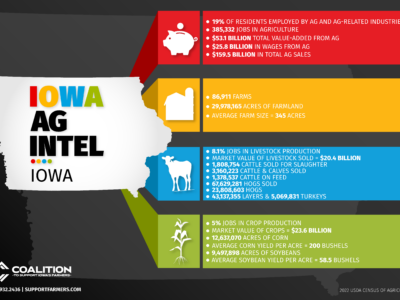Hurricanes could bring rain to Iowa during harvest
05-22-2012 in Livestock
When is the rain going to stop?’
That was the first question asked of Iowa State University Extension climatologist Elwynn Taylor when he spoke to farmers at the 2007 Market Ad__vantage Conference late last month.
The conference, organized by the Iowa Farm Bureau, was held in Fort Dodge, an area that struggled with flooding last week after receiving nearly one foot of rain in just five days.
However, Taylor told conference attendees that the heavy rains in northern and central Iowa weren’t all that surprising given the active hurricane season so far this year.
When hurricanes reach the Gulf of Mexico near Texas, Iowa typically experiences wet weather, Taylor said.
Last month, Hurricane Dean hit the eastern edge of Mexico along the gulf coastline.
Taylor said wind flows are pushing tropical air from Mexico straight through Iowa and into Canada, bringing rains along the way.
The hurricane season is expected to remain active through the end of November. Taylor said historic weather patterns indicate that Texas could become a target for another hurricane this fall.
‘If one month from now we get a tropical storm in Texas, we’ll have a wet harvest (in Iowa),’ Taylor said.
Yield prospects
So far this year, many regions in central and southwest Iowa faced unusually wet weather in early spring and late summer, while northwest Iowa suffered a long stretch of dry weather in July.
But despite the erratic weather, Taylor said weather conditions were generally favorable for crop development during the growing season.
He forecast that U.S. corn yields will average 152 bushels per acre in 2007, up 4 percent from the trendline yields and above the U.S. Department of Agriculture’s (USDA) current yield estimate of 150 bushels per acre.
And with most areas of Iowa experiencing a cool and wet summer, the state’s corn yields will likely increase from last year’s average yield of 166 bushels per acre, Taylor said.
The USDA projects that Iowa corn yields will average 180 bushels per acre.
‘We haven’t really had any bad weather in 20 years, which is why our crop yields have continued to improve,’ Taylor said.
Drought next year?
Yet Taylor warned farmers that the streak of good crop weather isn’t expected to last.
Historically, a drought hits the Midwest at least once every 23 years. The last major drought in Iowa was in 1988.
Taylor expects Iowa farmers will face another drought sometime before 2011. Whether a crop-damaging drought will occur next year depends on the arrival of La Nina, a weather phenomenon caused by the cooling of Pacific waters that brings dry weather to the Midwest.
Iowa farmers have a 70 percent chance of harvesting below-trendline corn yields in years when La Nina appears, Taylor said.
‘If the Pacific water cools by Christmas, we will have a drought year,’ Taylor said. 2007-09-07 00:00:00.000 NULL NULL NULL NULL NULL NULL NULL 1 0 1 Crop management strategies take on added importance Planting delays, weather challenges have implications. Weather concerns that started with planting delays will carry serious implications all the way through to harvest says Iowa State University Extension crop specialist Roger El__more.
The most immediate concern, Elmore said, is that farmers should delay fungicide applications on corn since the cool and wet spring pushed silking back about 12 days later than normal.
Spraying fungicides before tasseling can cause damage to ear formation, Elmore noted. Therefore, fungicide applications should be based on crop development, not the calendar, he said.
‘If farmers are spraying fungicides, they’ll need to go out in the field and look to be sure their crop is beyond silking; otherwise, it will be wasted money in terms of disease control,’ Elmore said.
The unevenness of the crop can also create problems with corn at different stages within the same field.
Models show that corn planted in mid-May’representing about 80 percent of Iowa’s corn crop’should have started silking July 17, Elmore said. Acres that were replanted around June 30 are likely to be silking in mid-August.
Farmers should check their corn for leaf diseases during tasseling to determine if a fungicide treatment is necessary, said ISU Extension crop specialist Paul Kassel, based in Spencer.
‘If there is a lot of leaf disease and you have hot weather, that increases your chance of getting a return on that fungicide dollar,’ he said.
George Cummins, an ISU Ex__tension crops specialist in Charles City, said farmers should also watch for corn rootworms feeding on silks.
‘We’re always concerned about the late-planted corn. That’s a magnet for rootworm,’ he said.
Soybean growers could experience a number of other problems due to the wet weather and delayed planting, ISU soybean agronomist Palle Pedersen said.
Late-planted soybeans will begin flowering when the plants are shorter this year since flowering begins based on day length, he explained. That means plants are likely to set pods closer to the ground, which could be a challenge during harvest.
‘ We’re going to shorten the growing season because of the wet weather,’ he said. ‘That’s going to have a huge impact on yields.’
His research shows that soybeans planted in late May and June produce about 2.5 fewer nodes per plant than those planted by early May, which translates into about 6 bushels per acre.
Soybeans are also more susceptible to certain diseases due to the wet spring, especially sudden death syndrome (SDS) and bacterial blight, Pedersen said. 2008-07-24 12:00:00.000 NULL NULL NULL NULL NULL NULL NULL 1 0 1 Save the date – Farming for the Future conference announced Annual conference to held Aug. 24.
The Coalition to Support Iowa’s Farmers is pleased to announce the date of their annual conference, “Farming for the Future” has been set for Aug. 24.
“This year’s conference is designed to answer questions and bring clarity to some of the concerns livestock and poultry farm families have when considering growing the farm,” CSIF Executive Director Brian Waddingham says. “It’s going to be an event you won’t want to miss. Experts will share insight on the rules and regulations, financial feasilbity and economic benefits of livestock production.” Additionally a multi-generational panel of farm families will share their experiences in growing the farm to bring the next generation back.
Be sure to put Aug. 24 on your calendar and watch the website (or sign-up for the E-Team newsletter) for more information!
Recommended News

Robbins Family Hosts Cattle Building Open House
Farmers interested in learning about the benefits of raising cattle under roof are invited to attend an open house at the Robbins family farm to tour Justin and Lacie Robbins...
Read More
NEW STUDY SHOWS IOWA AGRICULTURE EVEN STRONGER
Iowa’s 86,911 family farms continue to be a key driver of Iowa’s economy, contributing 32 percent more to the state economy than in 2017, according to a new study commissioned...
Read More
Farming is a Family Affair
The Streit family of West Bend, Iowa, has cultivated their farm for over three decades, fostering a legacy of hard work and community support. Diane and Tony Streit, alongside their...
Read More